Chinese Evergreen
- January 19, 2024
- 0 comment
The Chinese Evergreen (Aglaonema) is a true superstar of the houseplant world, adored for its easy care and stunning foliage. Native to tropical Asia, this evergreen charmer boasts glossy, oval leaves that come in a kaleidoscope of colors and patterns, from rich emerald green to vibrant splashes of pink and silver. Its low-light tolerance makes it perfect for brightening up any corner, even in dimly lit offices.
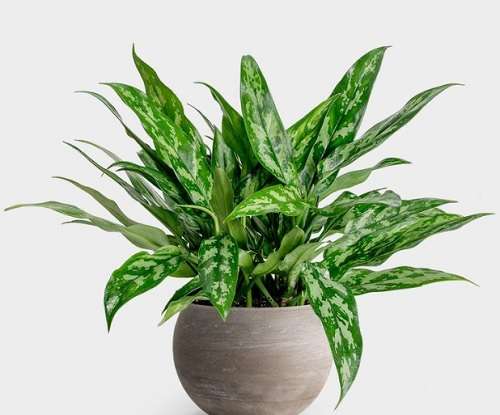
| Characteristics | Description |
|---|---|
| Scientific Name | Aglaonema |
| Common Name(s) | Chinese Evergreen |
| Type | Perennial, Houseplant |
| Origin | Tropical and subtropical regions of Asia and New Guinea |
| Size | Varies depending on cultivar, typically 1-3ft tall |
| Foliage | Glossy, elliptical leaves, 4-8 inches long, various shades of green with variegation in some cultivars |
| Flowers | Small, white or green, resembling calla lilies, bloom occasionally on mature plants |
| Light Needs | Low to medium indirect light |
| Watering Needs | Moist but not waterlogged soil, allowing top inch to dry before watering again |
| Soil Needs | Well-draining potting mix |
| Temperature Needs | Prefers 65-80°F, tolerates 55-85°F |
| Propagation | Stem cuttings, root division |
| Growth Rate | Slow |
| Toxicity | Mildly toxic to humans and pets if ingested |
| Benefits | Air purifier, low maintenance, visually appealing, considered good luck in Chinese culture |
| Potential Issues | Overwatering, root rot, mealybugs, bacterial leaf spot |
Description and Characteristics
The Chinese Evergreen is a highly valued houseplant, renowned for its large, glossy leaves with striking variegated patterns in shades of green, silver, red, and pink. These patterns can vary from speckles to stripes, differing widely among cultivars. Typically growing to a modest 1-3 feet in height and width, this plant is ideal for indoor settings. While it does bloom with small, peaceful lily-like flowers, they are often overlooked in favor of its vibrant foliage. The Chinese Evergreen is adaptable, thriving in medium to bright, indirect light and tolerating low light well. It requires moderately moist soil and occasional misting but is sensitive to overwatering. Besides its aesthetic appeal, the plant is known for its air-purifying qualities, though it is toxic if ingested and should be kept away from pets and children. Its combination of beauty, air purification capabilities, and ease of care makes it a popular choice for plant lovers of all experience levels.
A Spectrum of Colors and Patterns
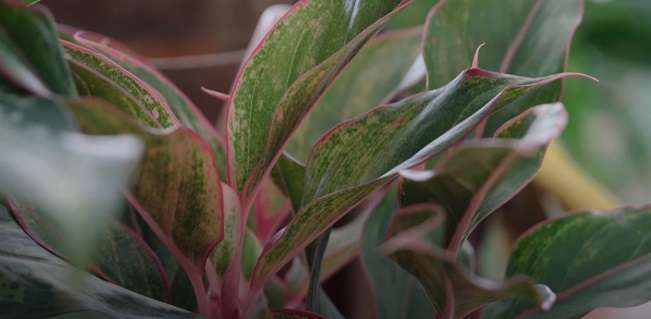
Chinese Evergreens are celebrated for their striking and varied foliage, making them a decorator’s dream. The leaves of these plants are their most notable feature, presenting an array of patterns and hues that can complement any interior design scheme. The basic palette ranges from lush, deep greens to intricate patterns with silver streaks or spots, creating a visual texture that is both intricate and soothing. Certain varieties of Aglaonemas push the boundaries of this color spectrum, showcasing leaves with vibrant red tinges, pink spots, or even strokes of yellow, offering a bold statement piece for any space. This remarkable variation in leaf color and pattern is not just a testament to the plant’s beauty but also to its genetic diversity, with each species and hybrid bringing its own unique aesthetic to the table.
A Living Tapestry in Your Home
Aglaonemas are decorative indoor plants with glossy, patterned leaves that add sparkle and depth to spaces. Available in compact or larger sizes, they suit various settings from tabletops to corners. Their leaf designs range from subtle marbling to bold stripes, making them versatile for both minimalist and vibrant decors. Aglaonemas bring natural beauty and diversity into living and working environments.
Benefits
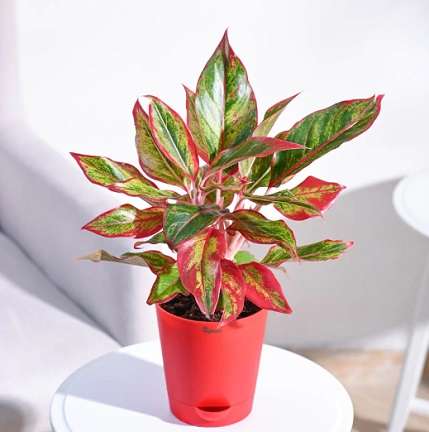

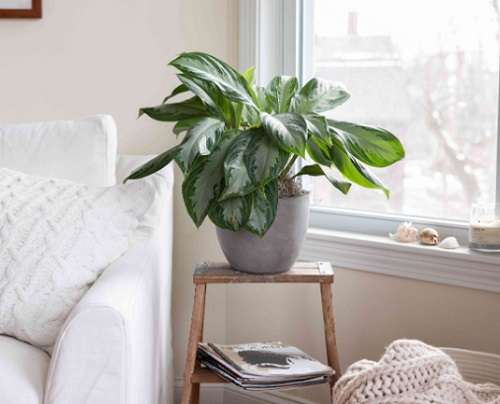
The Chinese Evergreen is appreciated not just for its beauty but also for its air-purifying qualities. It helps improve indoor air quality by absorbing toxins like formaldehyde and benzene, commonly found in household materials. This makes it particularly useful in urban homes and offices. Additionally, it enhances overall well-being by releasing oxygen and regulating humidity levels, serving as a practical addition to any indoor space.
Care and Maintenance
Light Requirements
The Chinese Evergreen thrives in low to medium light, ideal for offices or rooms with limited natural light. While it’s resilient in various lighting conditions, variegated Aglaonemas need brighter, indirect light to keep their colors vivid. Insufficient light may fade their patterns. Positioning these plants near east or west-facing windows for softer morning or evening light helps maintain their striking appearance, avoiding direct afternoon sunlight.


Watering
Aglaonemas are tropical plants and, as such, prefer a warm and humid environment. The ideal temperature range for these plants is between 65°F and 80°F (18°C to 27°C). They can tolerate lower temperatures, but exposure to cold drafts or temperatures below 60°F (15°C) can harm the plant. To maintain a conducive humidity level, especially in drier climates or during winter when indoor heating can reduce humidity, regular misting of the leaves can be beneficial. Alternatively, placing a humidifier nearby or using a pebble tray filled with water under the plant’s container can help increase the ambient humidity. These methods replicate the moist, humid air of their native habitat, contributing to the plant’s overall health and preventing issues like brown, crispy leaf edges.
Temperature and Humidity
Aglaonemas are tropical plants and, as such, prefer a warm and humid environment. The ideal temperature range for these plants is between 65°F and 80°F (18°C to 27°C). They can tolerate lower temperatures, but exposure to cold drafts or temperatures below 60°F (15°C) can harm the plant. To maintain a conducive humidity level, especially in drier climates or during winter when indoor heating can reduce humidity, regular misting of the leaves can be beneficial. Alternatively, placing a humidifier nearby or using a pebble tray filled with water under the plant’s container can help increase the ambient humidity. These methods replicate the moist, humid air of their native habitat, contributing to the plant’s overall health and preventing issues like brown, crispy leaf edges.

Soil and Fertilization

For soil and fertilization, Chinese Evergreens are not demanding. They perform best in a well-draining potting mix, which prevents water from accumulating around the roots, thereby reducing the risk of root rot. A mix designed for indoor plants, which typically includes components like peat, perlite, and pine bark, provides an ideal balance of aeration and moisture retention. When it comes to fertilization, Aglaonemas have modest needs. Feeding them with a balanced, water-soluble fertilizer diluted to half strength every few months during the growing season (spring and summer) is adequate. It’s important to avoid over-fertilization, which can lead to salt buildup in the soil and potentially harm the plant. During the fall and winter, when the plant’s growth naturally slows down, fertilizing can be reduced or stopped altogether.
Diverse and Captivating
The Aglaonema, with its stunning array of varieties, offers a unique aesthetic to suit any taste or decoration. Each variety, with its distinct characteristics, brings its own charm and elegance.
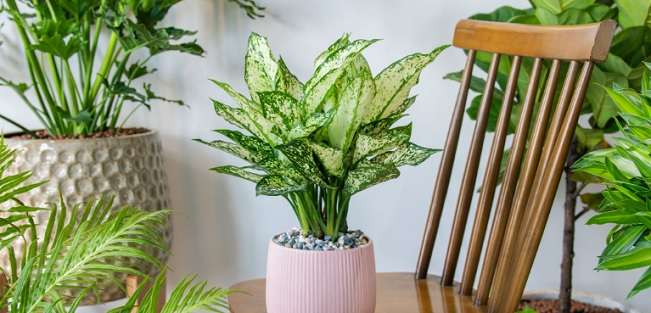
- Aglaonema ‘Silver Bay’ is known for its lush, silver-green leaves with a flowing silver pattern, ideal for brightening offices or modern spaces. It adapts well to various indoor conditions, including low light.
- Aglaonema ‘Red Gold’ features green leaves with vibrant red edges, adding warmth and color to any room. It thrives in bright, indirect light, perfect for enlivening subdued spaces or complementing earthy decors.
- Aglaonema ‘Cutlass’ has long, narrow leaves with silver streaks, creating a feather-like appearance. Its elegant shape is suitable for compact spaces, offering an airy feel. Like other varieties, it’s resilient and low-maintenance.
Each Aglaonema variety offers unique beauty and character, serving as a living element of decoration to suit different styles and spaces.
Conclusion
The Chinese Evergreen is a highly adaptable and low-maintenance houseplant, ideal for both novice and experienced plant enthusiasts. Its ability to thrive in various lighting conditions makes it suitable for any indoor setting. Valued for its aesthetic appeal, air-purifying abilities, and ease of care, this plant enhances indoor spaces not only visually but also in terms of health and ambiance.
FAQs
- What Light Conditions Are Best for Chinese Evergreen?
Chinese Evergreen thrives in low to medium light. Direct sunlight can scorch the leaves, so it’s best to keep them in shaded or indirectly lit areas. - How Often Should I Water a Chinese Evergreen?
Water when the top inch of the soil feels dry. They don’t require frequent watering, and overwatering can lead to root rot. - Is Chinese Evergreen Toxic to Pets?
Yes, it can be toxic if ingested. The plant contains calcium oxalate crystals which can irritate the mouth and digestive tract of pets. - What Temperature is Ideal for Chinese Evergreen?
They prefer warmer temperatures, ideally between 65°F and 80°F (18°C to 27°C). They are not tolerant of cold drafts or temperatures below 60°F (15°C). - How Do I Know if My Chinese Evergreen is Getting Too Much Light?
If the leaves are fading or the edges are turning brown, it might be getting too much light. Move it to a shadier spot. - Can Chinese Evergreen Improve Indoor Air Quality?
Yes, like many houseplants, Chinese Evergreen can filter out certain air pollutants, contributing to better indoor air quality. - How Do I Propagate Chinese Evergreen?
They can be easily propagated by division or stem cuttings. The best time to propagate is during the spring or early summer. - What Kind of Soil is Best for Chinese Evergreen?
A well-draining, peat-based potting mix is ideal. The soil should retain some moisture but not stay soggy. - How Often Should I Fertilize My Chinese Evergreen?
Fertilize lightly during the growing season (spring and summer) with a balanced, water-soluble fertilizer. Avoid fertilizing in the winter. - What are Common Pests that Affect Chinese Evergreen?
Spider mites, mealybugs, and scale insects can sometimes trouble these plants. Regularly check the underside of leaves and use appropriate treatments if pests are detected.


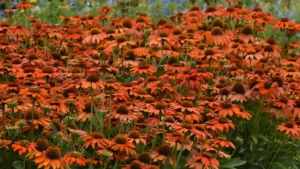

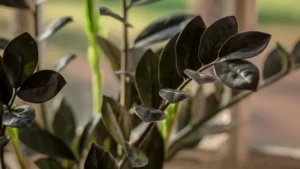

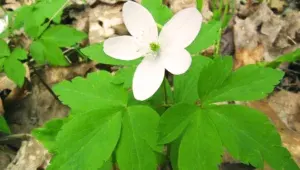
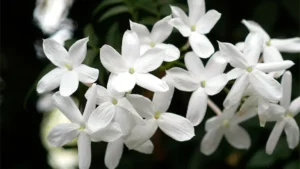
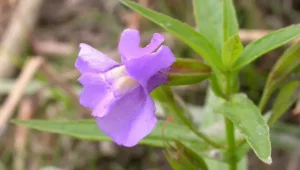
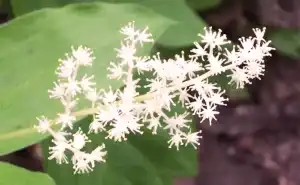
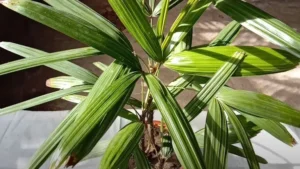

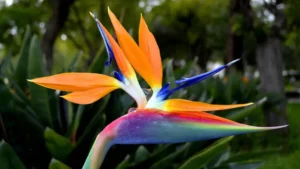
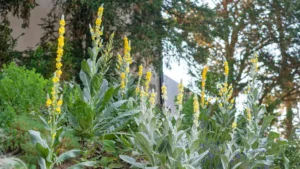
Leave your comment